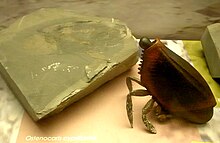| Ostenocaris Temporal range: Sinemurian to Callovian 198–164 Ma PreꞒ Ꞓ O S D C P T J K Pg N | |
|---|---|

| |
| Reconstruction | |
| Scientific classification | |
| Domain: | Eukaryota |
| Kingdom: | Animalia |
| Phylum: | Arthropoda |
| Class: | †Thylacocephala |
| Order: | †Conchyliocarida |
| Family: | †Ostenocarididae Arduini, Pinna & Teruzzi, 1980 |
| Genus: | †Ostenocaris Arduini, Pinna & Teruzzi, 1980 |
| Species: | †O. cypriformis |
| Binomial name | |
| †Ostenocaris cypriformis Arduini, Pinna & Teruzzi, 1980 | |
You can help expand this article with text translated from the corresponding article in Italian. Click for important translation instructions.
|
Ostenocaris is a Jurassic species of giant Thylacocephalan crustacean, sufficiently distinct from its relatives to be placed in its own family, Ostenocarididae. It is believed to be a bethonic animal and one of the most important necrophagous animals of its environment. Originally Interpreted as a bizarre barnacle. Ostenocaris is the most common fossil of the formation, and the main identified thylacocephalan from the formation. In the first interpretations, the genus was shown as a filter-feeding organism, which used the cephalic sac as a burrowing organ to ensure adhesion to the substrate. Based on the presence of Coprolites associated to the genus, with abundant masses of alimentary residues (hooks of cephalopods, vertebrates, remains of Crustacea) in the stomach of these organisms, Ostenocaris cypriformis was probably a necrophagous organism, and the cephalic sac can be tentatively interpreted as being a burrowing organ employed during the search for food, or as an organ of locomotion with intrinsic motility. Later studies agree that cephalic sac is actually extremely large compound eyes.
Distribution

Ostenocaris lived during the Sinemurian age of the Lower Jurassic, and has been found in rocks at two sites in the Italian Lombardische Kieselkalk Formation. This formation is known for its good preservation, with fossils of annelids, fishes, and plants, representing a relatively depth shelf deposit, where Thylacocephalans are the most abundant organisms. A second species found in the Middle Jurassic (Callovian) La Voulte-sur-Rhône Lagerstätte of France, formerly known as Clausocaris ribeti was reclassified as second Ostenocaris species. This species lived in a bathyal zone environment, in a depth most probably exceeding 200 m.
References
- Arduini, P.; Pinna, G.; Teruzzi, G. (1984). "Ostenocaris nom. nov. pro Ostenia". Atli Del/A Societcl Iraliwzn di Sc: Ienze Naturali e del Museo Civico di Storia Naturale di Milano, Miiano. 125 (1–2): 48.
- Pinna, G.; Arduini, P.; Pesarini, C.; Teruzzi, G. (1985). "Some controversial aspects of the morphology and anatomy of Ostenocaris cypriformis (Crustacea, Thylacocephala)". Earth and Environmental Science Transactions of the Royal Society of Edinburgh. 76 (2–3): 373–379. doi:10.1017/S0263593300010580. S2CID 85401617. Retrieved 2 May 2023.
- Jean Vannier, Jun–Yuan Chen, Di–Ying Huang, Sylvain Charbonnier & Xiu–Qiang Wang (2006). "The Early Cambrian origin of thylacocephalan arthropods" (PDF). Acta Palaeontologica Polonica. 51 (2): 201–214.
{{cite journal}}: CS1 maint: multiple names: authors list (link) - Pinna, G. (1985). "Exceptional preservation in the Jurassic of Osteno". Philosophical Transactions of the Royal Society of London B: Biological Sciences. 311 (1148): 171–180. Bibcode:1985RSPTB.311..171P. doi:10.1098/rstb.1985.0149. Retrieved 2 May 2023.
- Laville, T.; Forel, M.B.; Charbonnier, S. (2023). "Re-appraisal of thylacocephalans (Euarthropoda, Thylacocephala) from the Jurassic La Voulte-sur-Rhône Lagerstätte". European Journal of Taxonomy. 898 (1): 1–61. Retrieved 7 October 2023.
| Taxon identifiers | |
|---|---|
| Ostenocaris | |
This prehistoric crustacean-related article is a stub. You can help Misplaced Pages by expanding it. |